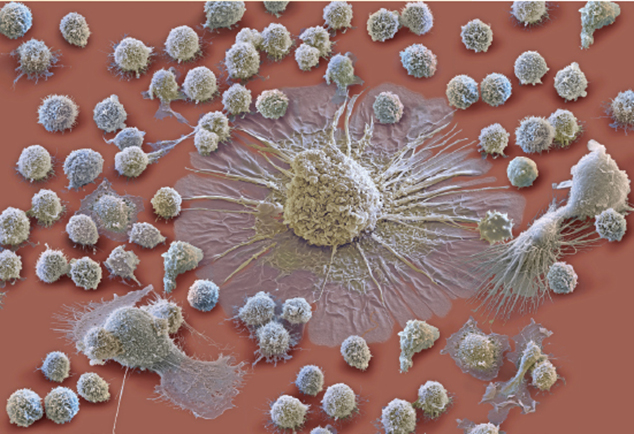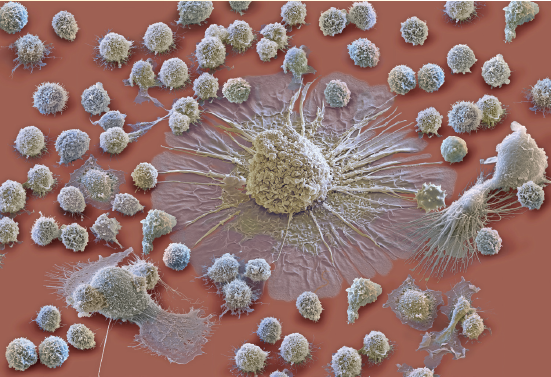CHAPTER 2 Reference Readings
Lesson 7
How do we know when we’re sick?
You might say, “I feel sick,” or “I don’t feel well.” But what does “sick” mean? For that matter, what does it mean to feel “well”? From the perspective of your body, it means that a number of critical characteristics are being maintained within fairly narrow ranges. Those characteristics include body temperature, and when our body temperature climbs higher than normal, we call it a fever, one of the most recognizable symptoms of illness.
What is “normal” body temperature?
But what is “normal” healthy body temperature, anyway? You may have learned that a “normal” body temperature for humans is 98.6°F, or 37°C. This is based on a study conducted in 1869. A more recent study found that the average temperature in a group of men and women was 97.7°F, or 36.5°C. This temperature not only varied from individual to individual, but also varied depending on the time of day for any one individual. This finding emphasizes that a healthy body temperature is not just one point, but exists within a range of temperatures. Nevertheless, most healthy people have an average body temperature between 96°F (35.6°C) and 99°F (37.2°C).
Healthy body temperature range for humans. Recent studies indicate that the average human body temperature is 97.7°F, lower than previously thought. The traditional 98.6°F, however, is within the healthy temperature range (left). Within any individual, body temperature also fluctuates over the course of each day (right).

If you are in a cold external environment, nerve cells in your skin sense this and relay the message to your brain. The brain then triggers your body to respond. You begin shivering, which generates some heat for your body. On the other hand, if you are outside on a hot day, the nerve cells in your skin sense this also and send a message to your brain that body temperature is in danger of increasing above the healthy range. Your body responds by sweating and diverting blood flow away from internal organs so that they are not damaged by excess heat.
Shivering and sweating are ways the body attempts to return our internal body temperature to the healthy range even as the external environment becomes colder or hotter.

Homeostasis
The body’s attempts to stay within the normal healthy range can be referred to as the process of homeostasis. Even though small changes and fluctuations may occur as the external environment changes, the body is usually able to maintain relative stability.
Symptoms and tests
Taking our temperature and seeing a number that is higher than our normal range reveals a fever. Any time our body’s levels deviate from normal can be an indicator that we’re sick. In fact, if they are concerned about the possibility of an infection, doctors often look at a variety of immune cells and molecules in the bloodstream by ordering blood tests. Each of these tests has a certain range within which most healthy people fall, and levels much higher or lower may indicate infection.
Lesson 8
Why do changes happen in the body when we’re sick?
Sick with symptoms
In addition to fever, we often feel a variety of other symptoms when we’re sick. In particular pain, heat, redness, swelling, and loss of function are all symptoms of inflammation. Inflammation is the body’s response to injury, irritants, or infection.
A look under the hood
Medical professionals may suspect harmful bacteria have entered and begun growing in the body, even if they cannot see outward symptoms of inflammation. They may collect a small sample of blood and run tests for cells and molecules that indicate inflammation. The table below provides an overview of three common tests.
Test |
Description |
|---|---|
C-reactive protein (CRP) |
• C-reactive protein is one of the first types of proteins produced in response to inflammation in the body. • It stimulates increased production of white blood cells. • CRP rises dramatically when there is inflammation. |
Complete blood count (CBC) |
• A complete blood count determines the number of red and white blood cells in the bloodstream. • The number of white blood cells is of particular interest because they are immune system cells. • This number rises dramatically when there is inflammation. • White blood cells destroy and remove bacteria and damaged body cells. • The white blood cells also alert other immune system cells to the presence of infectious agents. |
Erythrocyte sedimentation rate (ESR) |
• Erythrocytes are red blood cells that circulate in the bloodstream and transport oxygen to cells and carbon dioxide away from cells. • The ESR test measures the amount of time it takes for red blood cells to settle to the bottom of a test tube. • When there is inflammation, there is an increase in the amount of clotting factors in the bloodstream. Fibrinogen is one type of clotting factor. • When clotting factors increase in the blood, red blood cells tend to clump together more. Then they settle faster in the test tube. |
Tests for cell responses to inflammation.
If the CRP, CBC, or ESR tests are elevated, indicating an increase in the levels of CRP, white blood cells, or fibrinogen, doctors know that the body is experiencing inflammation, and could be being attacked by an infectious agent if no other injury or irritant is present.
How do these cells and molecules fight bacteria?
Just as on a battlefield, immune cells enact stages of defense. These stages include (1) detecting the invaders and the damage created, (2) destroying the invaders and removing them, and (3) mobilizing action, which includes using signals to alert others that may be further away to come and help, creating barriers to block the invaders, and aid in repairing damages.
White blood cells can detect molecules that are specific to bacteria as well as molecules that are released when our own body cells are damaged or killed. Some types of white blood cells can destroy bacteria by engulfing or “eating” them—digesting them and shredding them apart. Many white blood cells also mobilize action by sending signals to other immune cells and other parts of the body to assist with the immune response.
The white blood cell in the middle has released signal molecules (which we can’t see here) and it has attracted other white blood cells.

So why do we feel bad when our immune system is saving the day?
In order to create conditions that are conducive to immune system activity and a hostile environment for the bacteria, immune cells send signals to the brain that trigger fever, they increase blood flow to the site of infection, and they increase blood clotting. As you can see, some of the things your body does to fight the infection are responsible for making you feel bad.
Benefit vs. cost
A common symptom of a disease is fatigue. You may describe yourself as having no energy. You may have noticed that you often lose weight when you are sick, especially if the illness lasts several days or weeks. This is only partly due to eating less when you don’t feel well. It takes a lot of energy for your body to produce the extra immune system cells and proteins that fight infection in your body. In addition, body cells that are destroyed in the infection must be replaced.
In addition to the energy cost of maintaining the immune response, the ongoing inflammation caused by immune cells and molecules is harmful to the body. For example, people who have inflammatory bowel disease (IBD) experience ongoing inflammation that makes them more likely to develop other diseases as well. Thus, it is important that the body turn off the immune response once it has destroyed disease-causing bacteria.
Lesson 9
How can the body control its response?
Signal, target, effect
In order for the body to control its response, different cells and parts of the body need to be able to communicate with each other. Communication involves sending out signals that are received by a target. The signals that cells send are mostly in the form of small molecules that travel from one cell to another. Immune cells and the signal molecules they send often travel through the bloodstream to reach distant target cells. The activated target cell then responds to the signal by changing in some way or doing something. We can use the ideas of signal, target, and effect to understand some examples of systems the body uses to start and stop its immune response.
Amplification
At the site of a wound or infection, bacteria may be present. As you learned in the last chapter, human cells at the site of an infection are likely to be damaged. As long as they are alive, the bacteria cells are constantly producing some molecules, and the damaged human cells are constantly producing some molecules. Both types of molecules are signals to immune cells. These signal molecules may leave the site of infection and travel through the bloodstream. The signal molecules interact with receptors on white blood cells wherever they encounter those cells—at the infection site, in the bloodstream, or in lymph nodes or other parts of the body. The interaction has the effect of causing the white blood cells to change, or activate, and begin to travel to and respond to the infection. So, signals from the cells at the site of the infection can target white blood cells and affect them, causing the immune response to begin. Importantly, the white blood cells send out signal molecules that target white blood cells. So more white blood cells results in more of all the activities of white blood cells, including further increasing the number of new white blood cells. Therefore, the response amplifies as it goes on.
Inhibition
Turning off the immune response also involves signal molecules binding to receptors on target cells. When very high levels of some of the signal molecules involved in amplifying the immune system interact with the hypothalamus in the brain, the hypothalamus responds by sending a signal of its own to another part of the brain. The latter brain cells release special hormones into the bloodstream. Hormones are a type of signal molecule. In this case, the target cells for the hormones are cells in the adrenal glands that are found above each kidney. This hormone signal is important for turning off the immune response.
When the hormones bind to their target cells in the adrenal glands, they stimulate the cells to produce and release more molecules called glucocorticoids. The glucocorticoids move through the bloodstream and bind to receptors on their target cells, the white blood cells. This binding changes what the white blood cells do. For example, they cause the cells to stop producing amplification signals—and start producing other signal molecules that are inhibitory signals. They also decrease the number of white blood cells by programming them to die. Thus, the glucocorticoids act like “brakes” on the immune response, decreasing the production of C-reactive protein as well as the number of white blood cells.
Notice that the immune response not only stimulates the production of cells and molecules that are responsible for amplifying the initial response, but it also triggers the production of signal molecules (glucocorticoids) that ultimately decrease this response. The glucocorticoids produced provide feedback to the immune system that turns off the immune response.
Feedback: negative and positive
The concept of feedback is important for understanding how the body can control, or regulate, its activities to ultimately maintain homeostasis. Feedback simply refers to a process that is a cycle in which a later step affects (or feeds back to) the first step. One type of feedback continually increases, or amplifies, what is happening in the system; we call this positive feedback. Another type of feedback decreases, or inhibits, what is happening in the system; we call this negative feedback.

When feedback fails
Even the body’s own feedback mechanisms have a range within which they can effectively operate. Organ failure and even death can result from an infection that is too difficult for the body to fight. Patients with bad bacterial infections may go into sepsis, which refers to a hyperactive immune response, followed by an overcorrection crash resulting in a suppressed immune system.



